Toronto underwater in June after EMA carried out same plan there
Huber Avenue protest: “They say cut back, we say strike back!”
August 22, 2012
By Diane Bukowski
Part of a series: next stories on Toronto and EMA, Wall Street’s role in DWSD cuts
DETROIT– If Detroiters and residents of the six counties serviced by the Detroit Water and Sewerage Department (DWSD) don’t want their cities to face the massive floods that Toronto’s subway system and basements experienced in June, they need to wake up and smell the sewage—fast.
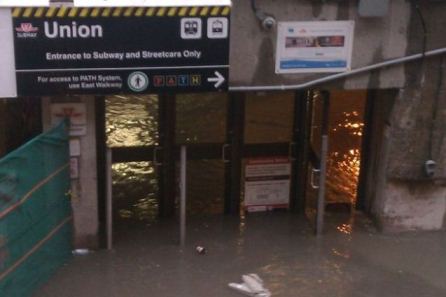
- Toronto Union Station underwater after massive city-wide flooding in June resulting from inadequate water/sewerage system.
On Aug. 8, Detroit’s suburban-controlled Board of Water Commissioners heard a proposed plan by the EMA Group, Inc. to eliminate 81 percent of the DWSD work force over the next five years. EMA Canada, Inc. carried out a similar plan for Toronto’s water and sewerage system beginning in 1999. In June of this year, storms flooded the city’s homes and subway stations, inadequately contained by Toronto’s water/sewer system.
On Aug. 15, 2012, DWSD workers and supporters picketed the DWSD Huber Avenue facility on the city’s east side, calling for community support. It was the third action meant to build for a city-wide strike related to contract negotiations. Supporting it may be customers’ only chance to avoid a disaster like that in Toronto.
“The city is paying EMA $175,000 for just the first phase of the project,” AFSCME Local 207 Vice-President Lakita Thomas told VOD on the picket line. “Phase II still has to be approved. EMA is busy going around talking to employees allegedly to find out what would make their jobs better, but then they plan to contract them out using the information they get.”
EMA wants DWSD to cut the workforce from its current budgeted total of 2,244 to 374 city jobs. Another 361 jobs, in so-called “non-core” areas including lab, security, maintenance, minor/major fleet repairs, payroll, legal, printing, billing and mailing, would be outsourced. In its report, EMA did not account for the costs of these private contracts.
“Mayor Dave Bing and the City Council are against us.” DWSD worker Kenneth Coleman said. “Who do we have that’s going to fight back except for us? People need to come out and speak their mind.”
Coleman said EMA claims to be doing interviews with people who do the front-line jobs.
“Well, I’m a welder and the person they talked to that they said was a welder wasn’t,” Coleman said. “They also interviewed a blacksmith, and they didn’t put that in the newspapers. People have no idea how important a blacksmith is to our operation.”
Local 207 Secretary-Treasurer Mike Mulholland carried a sign proclaiming, “81%? R U Nuts?”
“They claim the reason for the cutbacks is that rates are too high, but rates are going to go even higher under the EMA plan,” Mulholland said. He said the local plans to take a strike vote soon.
Workers chanted, “They say cut back, we say strike back,” and “Water and sewerage is a must, Detroit won’t go to the back of the bus.”
EMA claims annual savings would be $149 million, a paltry sum compared to DWSD’s total current annual budget of $932.4 million.
DWSD Director Sue McCormick said during her presentation to the BOWC Aug. 8 that debt payments account for 44 percent of the water budget and 40 percent of the sewerage budget, or approximately $382.5 million.
She did not address the billions of dollars the department spends every year on other lucrative private contracts, predominantly with non-Detroit-based businesses.
Instead, she said cutting operating and maintenance (O & M) costs is the only way to decrease water and sewerage customer bills.
“By 2013, we will see a 250 percent increase in sewerage costs for retail customers since 2003, and a 150 percent increase for wholesale customers,” McCormick said. “The water rates will have increased 200 percent for both.”
Retail customers are individual households in Detroit. The term “wholesale customers” refers to all the other municipalities in the DWSD service area.
“DWSD provides water service to the entire city of Detroit and neighboring southeastern
Michigan communities throughout Wayne, Oakland, Macomb, St. Clair, Lapeer, Genessee, Washtenaw and Monroe counties,” says the DWSD website. “The 1,079-square-mile water service area, which includes Detroit and 126 suburban communities, makes up approximately 40 percent of the state’s population. Wastewater service is also provided to a 946-square-mile area that encompasses Detroit and 76 neighboring communities.”
McCormick said the Michigan Department of Environmental Quality (MDEQ) told DWSD that in order to meet their regulations, bills must run less than two percent of the median annual household income. She said they are currently running 2.64 percent on sewage and one percent on water.
Presumably, the median annual household income was calculated from all six counties, since thousands of Detroiters have their water shut off because they cannot afford the bills and have incomes far below those of families in neighboring counties. The shut-offs are a factor in what DWSD claims is “declining demand.”

- EMA VP Brian Hurding (white haired man at helm) enjoying his yacht on Canada’s waterways, evidently unworried about Toronto floods.
EMA VP Brian Hurding, speaking with a distinct Canadian accent, told the BOWC that in addition to the staffing cuts, EMA is considering mothballing two DWSD operations plants and outsourcing large engineering projects. He also said changes in job design and the increased use of technology [VOD: read lucrative contracts] would further contribute to savings.
McCormick’s and Harding’s entire presentations can be heard in the video below.




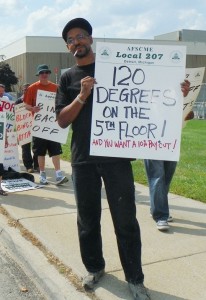
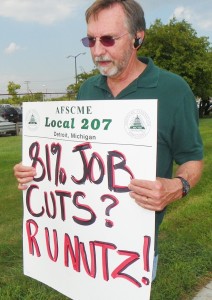
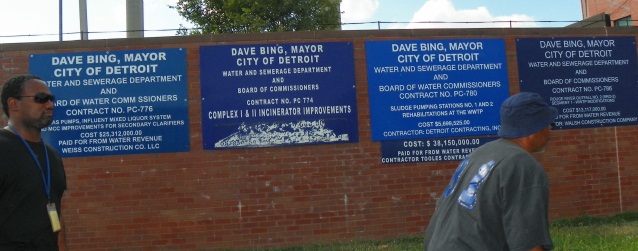

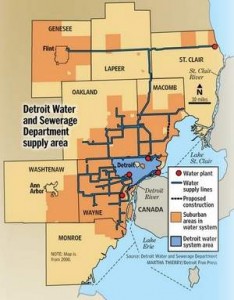





Submitted on 2012/08/29 at 2:01 pm
EMA report is a comedy. How can one cut 81 % from workforce and do well? There is no proof for such an action. Why hire such consultants, whose work is patently false? It seems that Hurding’s argument goes like this : if one does not pay wages, then one saves the money for wages. It is like saying if one does not use gas for driving, then one will save gas money. But will he be driving? If Hurding would have talked about new technology and how automated it would be, then one may look at his argument. But he did not talk about new technology. Hurding’s argument is basically flawed and can not be rescued.